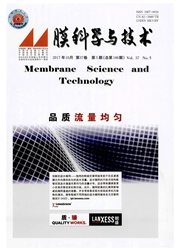

 中文摘要:
中文摘要:
采用L—S相转化法制备聚丙烯腈不对称膜,使用光学显微镜测试非溶剂在铸膜液中的扩散速率,结合光穿透实验、扫描电子显微镜及气体渗透性能测试结果,研究相转化过程中溶剂种类、铸膜液浓度及蒸发时间对成膜过程中孔结构形成过程的影响.结果表明:成膜工艺对相转化过程中的孔结构的形成有明显影响.不同溶剂制备的铸膜液其黏度及溶剂与非溶剂溶解度参数差不同,影响非溶剂在铸膜液中扩散系数.增加铸膜液浓度,其黏度增加;延长蒸发时间,膜的致密层厚度增加,二者都使非溶剂在铸膜液中的扩散系数下降,从而影响相转化过程中孔结构的形成.
 英文摘要:
英文摘要:
The asymmetric membranes were prepared by L-S phase mvermon method, upttcal mmroscopy was adopted to investigate the diffusion rate of non-solvent in casting solution. Light transmittance experiment, scanning electron microscopy and gas permeation test were used to investigate the effects of solvent type of the casting solution, casting solution concentration and evaporation time on the asymmetric membrane formation process. Results show that the pore structure of membrane formation process was affected significantly by technological conditions. Type of solvent affected the viscosity and intermiscibility of solvent and non-solvent, which caused the different diffusivity of non-solvent in casting solution and affected the pore structure formation during phase inversion process. Increasing the casting solution concentration caused the rise of viscosity and extension of evaporation time increased the dense membrane thickness which both decreased the diffusivity of non-solvent in casting solution and affected the pore structure formation during phase inversion process.
 同期刊论文项目
同期刊论文项目
 同项目期刊论文
同项目期刊论文
 期刊信息
期刊信息
